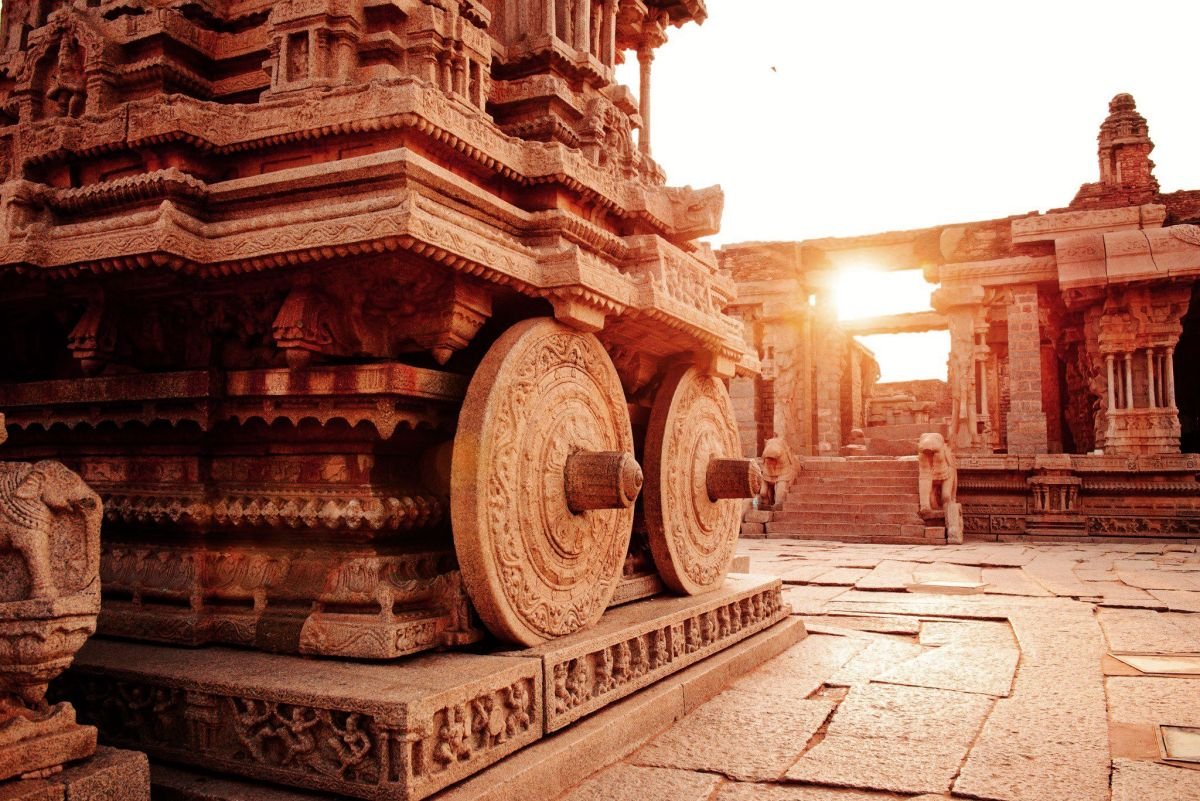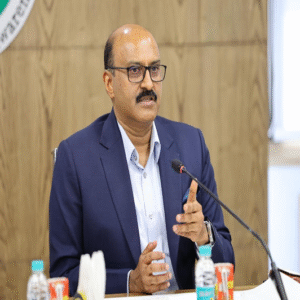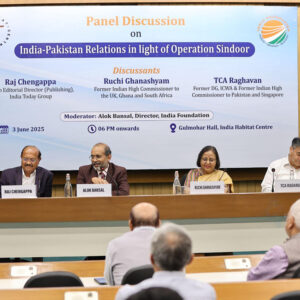Significance of Sacred Geospatial Areas
As famously said, “Sometimes it is impossible to know where you are headed without reflecting on where you came from”. Revisiting revered locations takes us to a land which today is the world’s oldest and only living civilisation. It is impregnated with deep-rooted, widely spread auspicious spaces of the original Bharata, a ‘viksit’ and the most sought-after destination. A vital step to regain that glorious status would be to revisit the sacred geo-landscape that gave traditional ‘Gyan-Vigyan’ and nurtured this ‘Vishva Guru,’ Bharatvarsha.
The mention of ‘sacred spaces’ takes us to ‘Bharata’, the terminology specifying a land of knowledge, the name instinctively evoking reverence. The G20 Summit of 2023 left a significant imprint as the invites from the President invoked our land’s original name ‘Bharata’; it gently reconnected us to our sacred identity, invoking a sense of pride, contrasting with ‘India’ that conjures up colonial baggage. What a blessing to reinforce its distinctiveness, signifying also the uniqueness of its meaning. ‘Bha-Ratha’ implies the land of ‘Bharatavansha’ kings and their kingdoms; it also denotes significant aspects that define our deep-rooted civilisation. ‘Bharata’ is a ‘ratha’ of ‘light’, a vehicle or carrier of knowledge. Knowledge is sacred, and so is the land that gave us our Gyan-Vigyan, Itihasa, Tiraths and remarkable places that were cradles of Bharatiyasabhyata.
Bharatiya Sanskriti (culture) evolved from Prakriti (nature), as is evident from our traditions, rituals, and celebrations, which coincide with the different seasons of nature and human life from conception to death. Centuries of tapasya (research) by Rishis (ancient scholars) led to comprehension of the universe and developed the philosophies and cultural understanding of the values of Mother Earth, our ‘Dharti Ma’. This reverence is so embedded that many among us wake up with a prayer to Mother Earth.
समुद्रवसने देवीपर्वतस्तनमण्डले।
विष्णुपत्नि नमस्तुभ्यं पादस्पर्शं क्षमस्वमे ॥
O Devi (Oh Mother Earth), You, Who have the Ocean as Your Garments, and Mountains as Your Bosom, O Consort of Lord Vishnu, Salutations to You; Please Forgive my Touch of the Feet (on Earth, which is Your Holy Body).
This blessed mother earth, Bharata, was a perfect cradle to give birth to the core civilisation’s wealth. The gift of this land’s spiritual energy developed profound systems of knowledge that still baffle many scholars.
As Rishis decoded the ‘Brahmaand’, travelling across vast geographical landscapes to study the ‘Prakriti’, the evolution of life and, more importantly, the meaning of life, they gained insight into every aspect of the sciences of life. Thus arose concepts of VasudhaivaKutumbakam and the four ‘ashramas’ of human behaviour and life systems—Brahmacharya, Grihastha, Vanaprastha and Sanyas. More profound perceptions of the functioning of the human psyche, mind and body, and affinities with nature led to the evolution of traditions of life management via the 16 ‘sanskaras’ that cover the circle of life from material birth to death to mingling back to nature. Evolved rulers and rishis patronised and promoted the learnings of the four Purusharthas of Kama, Artha, Dharma, and Moksha. Such enriching eternal principles for the prosperity and well-being of all humanity were the unique contributions of this motherland.
In this context comes the sanctity of particular locations. We have unique texts known as Mahatmya for all such sacred places. They comprise relevant knowledge from the Vedas, Ramayana, Mahabharata, and Puranas. Details of important rulers, the mandirs, and events of Itihasa are narrated. The Ayodhya Mahatmya facilitated the resolution of the Ram Janam Bhoomi dispute.
Similarly, we have Mahatmyas of Kashi, Kampilya, Indraprastha, Mathura, Braj areas, Bhalka, Dwarka, Prayagraj, and many ancient places across Bharata. This reveals a well-documented repository of sacred spaces, termed Tiraths, Mandirs, etc. Reviving them is reestablishing this land’s original identity and preserving it for posterity.
The ‘mandirs’ here were places of education, adhyatma (philosophy), and even centres of trade that followed dharmic principles. ‘Tirath’ implies places that evolved on the banks of rivers and water bodies and have historical and spiritual significance. Rivers have been the cradles of all civilisations. The Nadi Sukta of the Rigveda is considered the key to the sacred geography of Bharatavarsha[1].
गंगे !चयमुने !चैवगोदावरी!सरस्वती !
नर्मदे !सिन्धु !कावेरी !जलेSस्मिन्सन्निधिंकुरु।। (Rigveda 1.32.12)
Water bodies are the bedrock of our precious spiritual and historical geo-coordinates. Here developed iconic places and personalities having empowering influences since time immemorial, reflecting the times traversed from Vedic, Treta, Dwapar and Kalyuga, unfolding the trajectory of sacred landscapes of Bharata. Located within the Jambudweep continent, we learn how Bharata comprised almost all of South East Asia and much more. This article focuses on the current Bharata areas, left after being trampled upon and destroyed by invaders and colonial rulers and transformed by political ideologues. For brevity and priority, it highlights noteworthy sacred spaces that have reverberated in our hearts for centuries and reflect our nation’s universal beliefs.
According to astronomical data from the Mahabharata, the Kurukshetra War of the Dwapar Yuga occurred around 3067 BCE.[2] The Ramayana, on the other hand, is set more than 2,000 years earlier. The Vedic Satayuga is believed to be even further in the past.
Prayagraj
Considering rivers have been the source and nourishing mothers of our sacred geography, a tribute to them is overdue. The landmark initiative of restoring the original name of Prayagraj can be enriched if this most sacred confluence of our three significant rivers showcases their Itihasa. Interestingly, Yamuna is the sister of both Ganga, our ‘sangini’ through the earth, and Yam, the ruler of death. Along with Saraswati, representing knowledge, this ‘Sangam’ of three sacred rivers gets its significance with the Maha Kumbh Mela held here every 12 years. To pay tribute to our mother rivers, a ‘Naadi Sukta’ Darshan Kendra at Prayagraj and Floating Boat Museum on rivers will be a value-added connection to the ‘Prakriti-sanskriti’ essence of Sanatan culture and awareness for sustainable environment protection.
The storyline could cover ‘Avtaran’, Itihasa, the lands they traverse, traditions, and rituals of culture and cuisine. This entwining of Prakriti and Manushya will be an exemplary initiative that instils reverence and respect for sacred spaces. Recreating the ‘Saraswati journey of Balram’ will highlight many lost and forgotten places on its holy banks and invigorate interest in the past.
Ganga River Tirath
Gyanvapi: River Ganga’s ‘jal’ is integral in our lives from birth to death. Credited with the maximum number of holy sites, Ganga has the most profound connection to Shiva, who guided her path on earth. One of the most contentious and critical sacred spaces at Ganga banks is the Kashi Vishwanath Shivlinga. Destroyed on orders of the tyrant Aurangzeb, it awaits reclaim. For this reason, ‘Nandi’ has silently waited for centuries. The evidence of the original Shiva Linga screams out of the images on the walls of Gyanvapi, from Kashi’s Itihasa, from Mughal texts, and most clearly from the face of Nandi facing the Shivalinga of his Lord therein. The scientific survey by the Archaeological Survey of India (ASI) has also confirmed the pre-existent ancient temple and Shivalinga here. The authorities concerned must respect the beliefs and evidence to facilitate and expedite the handing over of the holy place to the Kashi Vishwanath Mandir. The complex has a beautifully designed building but could be further enhanced with ‘Prakriti’ of sacred groves and Nakshatra trees that hold the key to environment cleanliness.
Kampilya: Sacred Ganga bestowed us with another ancient Tirath, the cradle of Vedic wisdom from time immemorial. Kampilya is the ancient Samrajya, when King Sudas was so powerful that he expanded his empire up to Punjab in the west and Saket in the east. He also defeated Samvaran, the father of Kuru, in Hastinapur. Kampilya is mentioned in Vedas, Ramayana, and Mahabharata and was the pivotal point of Adhatyatma. It had intellectual rulers who promoted scholars in lakhs and spread Vedic knowledge worldwide. Its scholars developed the structure of Vedic shlokas. Here evolved the Ayurvedic book Charac Samhita, the Karmakand, the original version of Kamasutra, the Upanishads, etc. Besides the Vedic lineage Kampilvasini Mandir, the Rameshwar Mandir was established by Shatrughan, brother of Sri Rama. In Dwapar, Draupadi established the Shiva Temple after her marriage, as she learns that Pandavs are Shiva’s avatar and she is reincarnated Parvati.[3]
In 1920, Kampilya was among the centrally protected sites of the Archaeological Survey of India. However, 99% of its ancient heritage landmarks have been systematically destroyed, stolen and subjugated with buildings by vested ideological/ political interests. The Gazette of Farrukhabad gives its importance as the birthplace of Maharani Draupadi. Draupadi Swayamvar was also solemnised here, which event reflects in the Uttar Pradesh state symbol. The antiquity and relevance of this holy Tirath have been downplayed despite volumes of evidence. This forgotten marvel symbolises the strength of Vedic knowledge and the glorified status of women in ancient Bharata. It is also famous as the birthplace of Varahmihir, the writer of Brihatsamhita, and credited with 27 Nakshatra mandirs of Mehrauli, Delhi.
Kampilya[4] has great antiquity and is home to Kampilyavasni Mandir, mentioned in Yajurveda.
प्राणायस्वाहामानायस्वाहास्यानायस्वाहा।
अम्बेऽअम्बिकेऽअम्बालिकेनमानयतिकश्चन।
ससस्त्यश्वकःसुभद्रिकांभद्रांकाम्पीलवासिनीम्।। 23/18
Kampilya is mentioned in the Balkand of Valmiki Ramayana, and Brahmadatta, the 12th descendant of the Ikahvaku dynasty, ruled here like Indra.
सराजाब्रह्मदत्तस्तुपुरीमध्यवसत्तदा।
काम्पिल्यापरयालक्ष्म्यादेवराजोयथादिवम्।।बालकाण्ड33/19
Somak, Sanjal, Durmukh, and PravahanJaivali were rulers of this line associated with Kampilya. The Shatapath Brahman mentions that King Kaivya and Durmukha performed Ashvamedh’s sacrifice at Kampilya. The Mahabharata provides a detailed description of the city. Draupadi, the daughter of King Drupad, and his son Dristadyumna were born here (Mahabharata 1/166/39-44).
The commentator, Mahidhar, explained that the ladies of Kampilya were learned and beautiful. Mammat shares this view in his commentary on this verse.[5]
काम्पीलवासिनीम्काम्पीलनगरेहिसुभगाःसुरूपाःस्त्रियोभवन्ति।
Yamuna River Tirath
The oldest recorded sacred places on the Yamuna River plains are Indraprastha, Mathura, Vrindavan, the Braj Kshetra, and Prayagraj. The antiquity and sacredness of any nation’s Rajdhani gives deep insights into that country’s eco-political importance and civilisation strength.
Indraprastha: Bharata’s most ancient capital, Indraprastha, the ‘Swarg’ of Indra and Pandavansha, is now a city of graves transformed by people with ulterior motives.
Indraprastha dominated world trade and politics for the most prolonged period. UNESCO’s World Heritage Day is a yearly celebration of the beauty of monuments and the maintenance of their identity from their roots. The greatest irony of celebrating any monument’s ‘identity from roots’ is reflected in our Capital region. Do we celebrate the ‘roots’ of the most ancient sacred spaces here at Mehrauli – Yogmaya Mandir, the scientific wonder- VishnugiriStambh (Iron pillar), the 27 Nakshatra Mandir (astronomical observatory of Varahmir, whose location has ironically been a UNESCO site of ‘medieval time and name’- Qutub Minar, even though it displayed an inscription of 28 temples). In the Mehrauli area were inscriptions of Shankarashana and the 1st BCE Ghosundi mentioning Narayana Vataka. These are the real roots of Bharata. Likewise, the most ancient Indraprastha Qila and the mandirs of Pandavavansh or Raja Bhoja within this complex have never been celebrated on World Heritage Day. UNESCO and ASI have ignored the ancient Nigambodh Ghat, where the Vedas were revived, and the Nili Chhatri mandir of Sri Krishna at Rajghat. The Indraprastha Tirath points at Yamuna banks lie in a pathetic condition. Two ancient inscriptions are located at Safdarjung Tomb, but the roots are hidden and neglected.
Fortunately, traces of ancient legacies still exist, daring subjugation under medieval and colonial onslaught. The sacred landmarks of civilisation and ancient heritage legacies, the roots of our capital region, which is the face of Bharat to the world, need a facelift and a skyline of actual history. A tall statue of Yogeshwar Sri Krishna facing the Rashtrapati Bhawan or Sansad or at Kartavya Path will be an acknowledgement of his contribution as founder of Indraprastha and proponent of Kartavya.
The antiquity of Indraprastha, which was promoted by the moniker ‘Delhi’, denting its originality, is revealed in Indraprastha Mahatmya. The text records the vast geographical location of Indraprastha, mentioning Kashi at a distance of 21 Dhanush from its west point. It also tells us that it is as important a ‘Tirath’ as Haridwar, Prayagraj, Pushkar, etc.
The first mention of a sacred land area named Indra’s land appears in the Narad Purana (pp 645- 647) and Vishnu Purana (pp 870-875). Narsingha had killed Hirankashyap and saved Bhakta Prahalda. Subsequently, King Indradev was gifted with this ‘Swarga’ land, and Guru Brihaspati was advised to perform Yajnas and purify the Khandav Forest around the Yamuna River banks.[6]Brahma, Vishnu, and Mahesh blessed this Yajna, leading to its special sanctity. Sri Vishnu told Indra Devta to donate ‘prasthas’, or 48 handfuls of pearls/gems, to pious people after Yajnas. Prastha also means a plateau. The place where Indra gave ‘prasthas’ of wealth became Indraprastha. HonouringIndradev and antiquity, during Dwapara Yuga, Sri Krishna chose this holy land to be the central point of Pandava’s Indraprastha Kingdom and its Rajdhani.
‘Love your monuments; they are part of a rich civilisation and speak volumes about a bygone era’. It is a ‘monumental’ task to find the complete ancient remains of sacred spaces in an area that was deliberately trampled upon and, for centuries, systematically destroyed. This defeats the often-said view – “A rich cultural heritage depends on the ability of people to maintain their distinctiveness and unique identities”.
Reclaim and Revive Subverted Sacred Spaces at Indraprastha
Nigam Bodh Ghat is actually ‘Nigam’ or place where Rishis once again ‘recollected’ the Vedic Knowledge, i.e. had ‘Bodh’. How this specific place, at Yamuna River banks, was converted to a cremation is a mystery. The most significant event here was the auspicious ‘Yajnas’. Special efforts to revitalise the original spiritual and philosophical character of the precious Nigam Bodh knowledge area, renaming the Zone as Nigam Bodh Kshetra by DDA, will be ‘justice delayed but not denied’.
Indraprastha Pandav Kila has been popularised as Purana Qila to wipe out its original identity. Located at Mathura Road, the Ain-i-Akbari mentions that Humayun settled here for a few years before Sher Shah Suri defeated him. Humayun returned victorious after years but died within a few months. The last Hindu ruler at Indraprastha was Hemu Chand, who defeated Akbar’s army and crowned himself King there. This was a sought-after place because of its antiquity. The Sabha Parva of Mahabharata details its making, description of the grand forts with huge white walls secured by armed men, white double-storied buildings, and the beautiful lotus pond, which Duryodhana mistook for a carpet and fell in. Architects have recreated some perspectives of Indraprastha. Restoring some of the iconic structures at this Qila, its original white form, with the lotus pond, will be natural justice for the shaken roots of its historical legacy.
The Vishnugiri Hari Stambh (Iron Pillar) at the Qutub complex area, which has defied rust for centuries, is a testimony to ancient Bharata’s expertise in metallurgy. Quoting mediaeval historian Firishta, historian Dr Ved Veer Arya has traced its antiquity to around 950 BCE. Highlighting this and the redevelopment of the 27 Nakshatra Mandir, the Astronomical Observatory of Varahamir will nourish the natural heritage legacies of the National Capital Territory (NCT). Indraprastha, the first urban city of North Bharata, had deep links to Mathura Dham and Braj Kshetra.
Mathura is one among the Saptrishi or seven holy cities, and Mokshyadayni Tirath. The Ramayana credits Madhu of the Yadu tribe as the founder of Mathura and narrates how Shatrughna defeated his son Lavanasura and ruled here. Though the whole Brajkshetra circuit has great spiritual and historical significance, the most sacred land is the birthplace of Sri Krishna at the Kesava Deo Temple. This and the Dwarkadhish Temple display the beauty of traditional Indian temple architecture. The destruction of the sacred Krishna Janmabhoomi temple, the holiest place for all Sanatanies, is a continuous thorn in our hearts. The process of reclaiming Sri Krishna’s birthplace has been initiated, yet the troublemakers keep denting the efforts. Like Ram Janmbhoomi, Krishna Janmbhoomi awaits a grand revival, with government and well-meaning citizen devotees sincerely fulfilling their responsibilities. We are all eager to see the majestic Keshav Deo Mandir revived and re-energised to bless devotees. It is good news that Mathura has been chosen as a city for the Government of India’s Heritage City Development and Augmentation Yojana scheme. This will stimulate interest in Itihasa.
Our sacred spaces have given spiritual enlightenment because they were ‘grounded’ with ‘sacred groves’. Such virtuous places need greenery of Nakshatra Bagh, flower gardens, and widespread space with shades of the traditional trees that are endemic to climate management. Pilgrims need shaded relaxing areas. The proposed Braj Corridor has to avoid the complete tiling that inconveniences pilgrims walking during summer or rainy season. Equally critical is the redevelopment and beautification of the riverfront and river waters across Mathura. The twenty-five ancient Ghats have Vishram Ghat at the centre, where Sri Krishna rested before departing for Dwarika. It also has the temple of Charchika Devi, whose inscription has been found at Vidisha mandir, Madhya Pradesh. The revered and spiritual feel of Vrindavan Riverfront Ghats could be enriched with good landscaping by reclaiming it.
‘Pavan Bhumi’ Brajmandal carries forward the Vedic, Treta, and Dwapara legacies. Prioritising, reclaiming, and reviving this place of antiquity will nourish our ‘Dharovar’. The Goverdhan Parikrama and the Brajmandal Parikrama could use a beautification plan and be improved for pilgrims’ ease.
Kurukshetra: This is our connection to the sacred land of Bhagawad Gita, the Dharma Kshetra- Kurukshetra. Besides the Brahma Sarovar and the Gita Museum at Jyotisar, much more is required to generate awareness about the deep roots of civilisation linked to the Saraswati River. Excavations in the Indus-Saraswati areas have revealed Vedic Gyan Vigyan. Kurukshetra also has a 48 kos Parikrama, considered very sacred in our texts. An exciting revival could be the recreation of the ‘Saraswati journey of Balram’ even here. This can revitalise many sacred lands mentioned in the Mahabharata.
धर्मक्षेत्रेकुरुक्षेत्रेसमवेतायुयुत्सवः।
मामकाःपाण्डवाश्चैवकिमकुर्वतसञ्जय।।॥१/१॥
हेसंजय! जबमेरेऔरपाण्डुकेपुत्रयुद्धकरनेकीइच्छासेकुरुक्षेत्रकीपुण्य-भूमिमेंएकत्रितहुएतबउन्होंनेक्याकिया ?
Heritage of Kashmir: Rishi Kashysap’s land, Kashmir, has many sacred spaces of high academic and spiritual wealth. Among the three holiest shrines of Kashmir, along with Amarnath, are two precious pilgrimage sites, the Martand Mandir and Shardapeetham. Martand Mandir was destroyed in the 13th century by Sikandar Shah Miri to Islamise and subjugate the locals. Historian Kalhan credits Lalitaditya Muktapida for having commissioned its making in 8 CE at Anantnag. It is devoted to Surya, a prime deity of the Sanatan faith, and is now dilapidated despite ASI patronage. ASI has had no objections to the ‘renovations and beautification’ of mediaeval heritage but prevents the revival and reconstruction of Sanaran sacred buildings.
Kashmir is so integrally linked to Shardapeeth’s spiritual ethos that it gained the moniker of ShardaDesh. Situated near Neelam / Krishna River, Shardapeeth is also a Maha Shakti Tirth, the traditional location of Devi Sati’s right arm. Around 6th – 12thCE, it was among the most prominent Temple universities of Akhand Bharata. Historical texts like Rajatarangini, traditional scriptures, and Al-Biruni’s chronicle reveal how it was the most sought-after university, enriched by a well-stocked library and Vedic scholars. Shankaracharya’s were trained and selected here. Currently, its ruins are in Pak-Occupied Kashmir, about 10 km from the border. Till Bharat regains its entire Kashmir lands, an arrangement can be initiated for devotees’ visits on the lines of the Kartarpur Sahib Sikh shrine in Punjab across the Indo-Pak border.
Conclusion
Reading historical texts of Muslim invaders or modern thinkers like Sitaram Goel, we learn of the unending list of lakhs of sacred spaces of our Itihasa that were mutilated and superimposed with mediaeval structures. Many have been completely transformed, while some are deliberately kept in ruins to show the vicious subjugation done across the north, east and west of Bharatvarsha, a region that bore the brunt of attacks. Places of remotest antiquity are the roots awaiting nourishment to bring alive our tree of civilisation. Controversial Black American nationalist political activist Marcus Garvey authenticates it as: “A people without the knowledge of their past history, origin and culture is like a tree without roots”.American Author Steve Berry’s quote indicates the move ahead for Bharata – “A concerted effort to preserve our heritage is a vital link to our cultural, educational, aesthetic, inspirational and economic (scientific) legacies—all of the things that quite literally make us who we are”. Our sacred geography, traced from Nadi Sukta, the Mahatmyas and various historical texts, encompasses geo-coordinates to all these subjects of values. For current ‘India’ quoting from our traditional sources would bracket this article into the ‘Hindu revival’ remark of late J.L Nehru made to subvert reconstruction of Somnath Mandir.
Author Brief Bio: Neera Misra is an Independent Researcher focused on Vedic and Mahabharata period history and culture, and its socio-cultural impacts. She is the Founder Trustee and Chairperson of Draupadi Dream Trust.
References:
[1] Prof. Deen Bandhu Pandey has also referred to the Narada Purana shloka (नारदपुराण, 1.27.33) naming the major rivers.
[2]The Mahabharata Revisited, 2012, Chapter 5, Prof. Narhari Achar.
[3]KampilayaMahatamaya, 2003, translated by Durga Datta & Corrado Puchetti, D.K Prints
[4]The early rulers of Kampil relating to Krivi (Rigveda 1/30/1, 8/2/24, 8/22/12, 8/87/1, 9/9/6), Turvasu (Rigveda 1/36/18, 5/31/8, 6/20/12, 8/4/7, 10/49/8), Keshin (Shatapath Brahman 11/8/4/6), Shrinjai (Rigveda 4/15/4, 6/27/7, 6/47/22) and Somak families are frequently mentioned in Vedic literature.
[5] Prof D.P. Tewari Report Kampilya Excavation 2010-12
[6] 63, 64 in pages 174 and 175 of, Sing, Om Prakash, 2013, Adi Patrakar Narad aur Unki Patrakarita, Classical Publishing Company, New Delhi




